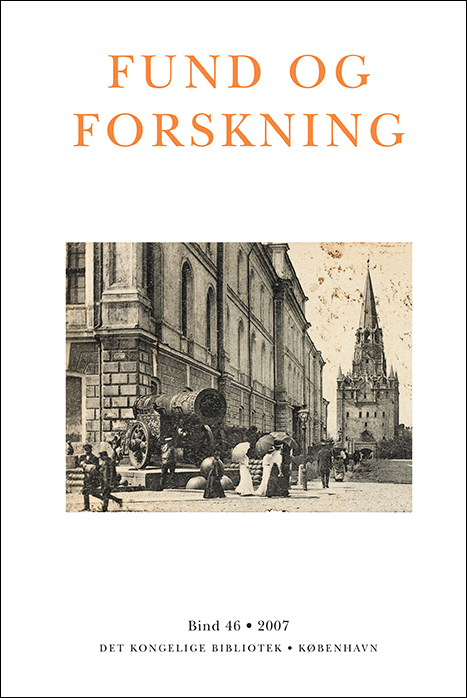Fragmentum Gregorianum Hauniense. Om et fragment af Gregorius’ Historiae og dets historie
DOI:
https://doi.org/10.7146/fof.v46i0.41191Resumé
More than half of the Medieval Latin manuscripts of the RL were copied after the year 1400. Only three can be dated to the period before 800. Of these the oldest is a single leaf in the library’s New Royal Collection, NKS 1878 2°. With lacunae due to the loss of the outer edge of the leaf it contains the text of the Historiae of Gregory of Tours from liber V, cap. 1, “filium eius paruulum …” to cap. 3 “… morte praeuentus interiit”. The paper offers a detailed codicological and palaeographical description of the fragment that measures 29,6 > 29,4 × 20,7 > 19,7 cm. The text is written in uncials in two columns, in scriptura continua. There are few abbreviations and a fairly elaborate system of ligatures. There is a detailed graphic system for the division of the text into sentences, parts, chapters and books. Corrections made during the process of writing are seen as an expression of the painstaking ambition of those who produced the book. A later hand changed odd forms of spelling in the text, such as ra 18 teniri (teneri), rb 21 decerniret (decerneret) and vb 19 locoplitatus (locupletatus).The first symptom of scholarly interest in the fragment is a note on the leaf identifying the text in 1697. When and how the fragment came to Copenhagen is not known. It was recorded in the inventories of the RL as late as 1923, but it was in the library and had become known to the scholarly public long before. Its textual contents were published twice in 1884, in France by Henri Omont, and in Germany by Wilhelm Arndt in his edition of Gregory’s History in the Monumenta Germaniae Historica. Who actually discovered the fragment in Copenhagen is not clear. Omont bestowed the honour on Léopold Delisle, whereas Arndt pointed out Georg Waitz as the finding father. The fragment in Copenhagen was published together with two other fragments written in uncial letters, one in Leiden (Universiteits-Bibliotheek, Bibl. Publ. Lat. 21, ff. 1-2), another in the Vatican (Bibliotheca Apostolica Vaticana, Reg. Lat. 689 bis, ff. 322-325). Omont believed they were pieces of three different codices, whereas Arndt thought they were parts of the same codex, which he described as vetustissimus et praestantissimus. Arndt’s successor Bruno Krusch disagreed, and pointed to differences in script and measures. An examination of the sources makes it clear that the three fragments are, in fact, leaves from the same codex, as was also stated by E.A. Lowe in Codices Latini Antiquiores part I. The dating of the codex to the 7th century has been met by broad consensus, with the exception of Krusch who suggested the early 8th century. Lowe favoured the later part of the 7th century in CLA part I, but changed the date to the first part of the same century in CLA part X, a point of view supported by the author of this paper. It is concluded that the seven leaves in Copenhagen, Leiden and the Vatican are the remnants of the oldest known codex containing Gregory’s History, and as such an invaluable source for the study of the Latin of Gregory, for the constitution of his text, and for the understanding of its complicated transmission. Based on Gregory’s admonition to his successors concerning the preservation of his work in book X of his History, based also on the analysis of the seven leaves it is further suggested that the codex to which they belonged must have been produced in Tours. Thus the leaves also form an invaluable source for the study of the production of books in Tours in the pre-Carolingian era, a period described by E.K. Rand as “wrapped in obscurity”.Downloads
Publiceret
2014-05-15
Citation/Eksport
Petersen, E. (2014). Fragmentum Gregorianum Hauniense. Om et fragment af Gregorius’ Historiae og dets historie. Fund Og Forskning I Det Kongelige Biblioteks Samlinger, 46, 7. https://doi.org/10.7146/fof.v46i0.41191
Nummer
Sektion
Artikler


